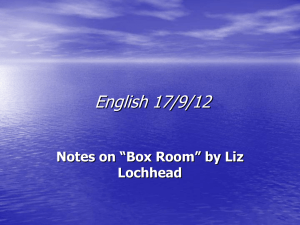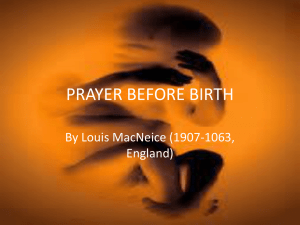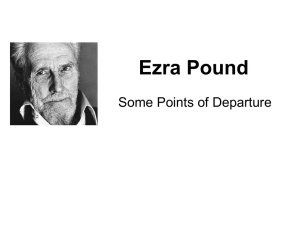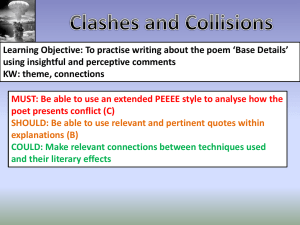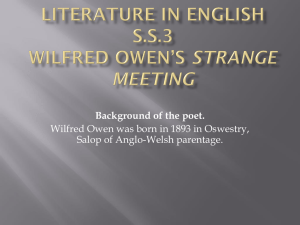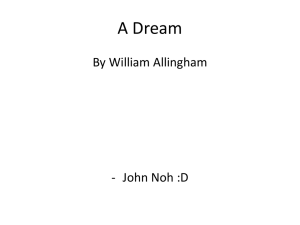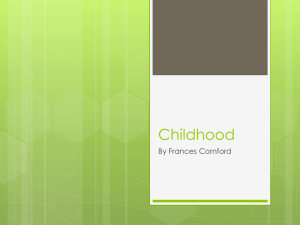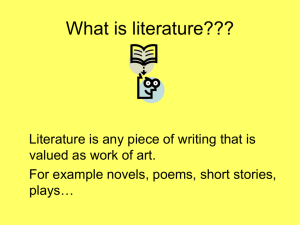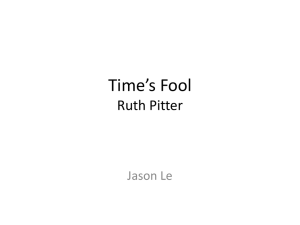Writing on Unseen poetry1
advertisement
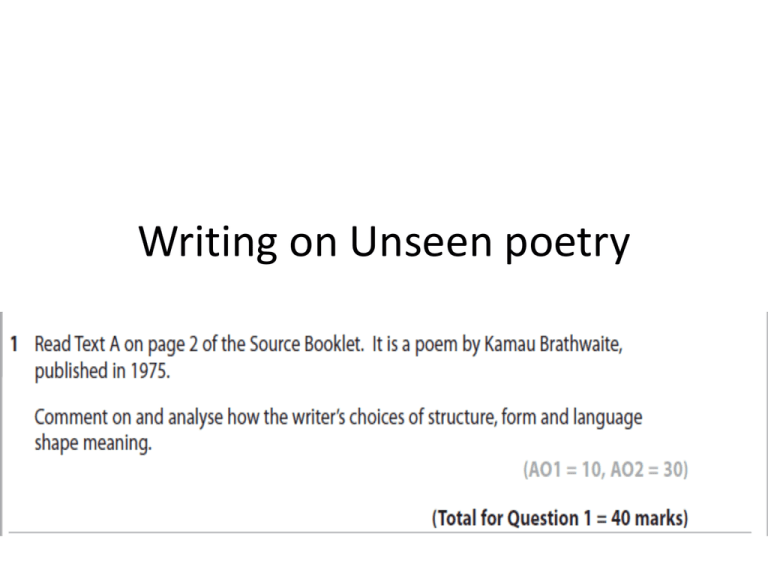
Writing on Unseen poetry Language, structure and form Language Structure Form • • • • • • • Rhyme scheme (or lack of) • Rhythm • Pace • Repetition • Stanza arrangement • Punctuation (or lack of) • Sentence length • Caesura • Enjambment • What does the poem look like? • Order (or lack of) • Overall shape (circular, contrasts etc.) It is a poem! What are the conventions of poetry? Word choice Imagery Simile Metaphor Personification Sound devices (assonance, alliteration, sibilance, fricative/plosive alliteration, onomatopoeia etc. • Word groups (semantic fields) • • • • • • • Hidden meaning Different interpretations FLIRTS/LIES etc. Sound devices etc. 1st person/3rd person Poetic voice Is it a sort of poem you recognise (e.g. sonnet etc) None of this matters unless you can link it to meaning- What effect is the poet trying to create? Language Structure Form • • • • • • • Rhyme scheme (or lack of) • Rhythm • Pace • Repetition • Stanza arrangement • Punctuation (or lack of) • Sentence length • Caesura • Enjambment • What does the poem look like? • Order (or lack of) • Overall shape (circular, contrasts etc.) It is a poem! What are the conventions of poetry? Word choice Imagery Simile Metaphor Personification Sound devices (assonance, alliteration, sibilance, fricative/plosive alliteration, onomatopoeia etc. • Word groups (semantic fields) • • • • • • • Hidden meaning Different interpretations FLIRTS/LIES etc. Sound devices etc. 1st person/3rd person Poetic voice Is it a sort of poem you recognise (e.g. sonnet etc) Themes? • • • • • • • • • • A theme is an idea that is explored in a text e.g. Nature Death Themes are Time ideas! They Love are usually Youth Conflict abstract nouns Grief that the poet Human nature explores in Etc…. concrete forms! meaning • The poem explores… Writing on poetry • Detailed exploration of the techniques used and how they contribute to the writer’s ideas on the themes explored. • Which means… • Find a poetic technique (language/structure/form) and explain how and why the poet has used it to put across their message • Stage 1 (point)- Explain which technique the poet uses and what they use it for. • E.g. The poet manipulates the line length to evoke the spectre of death. • Stage 2 (evidence)- Find a good quote to support your point: e.g. For example: “and breath Is short” • Stage 3- Analyse the quote in detail: “and breath Is short” Examiners love: • Detailed analysis- focus on key words etc. • Link the specific quote to other parts of the poem to develop/support your point • Confident explanation of why a technique has been used • Different interpretations/layers of meaning • Stage 3- Analyse the quote in detail linking it to the rest of the poem and offering different interpretations: • E.g. The shortened lines mirror the message that life is coming to an end. The use of foreshortened lines in comparison to the previous stanza suggests a countdown or a diminishing into nothingness which can be seen to represent the act of aging and death. By moving from ‘time’ to ‘life’ to ‘breath’ the poet is narrowing in from the abstract to the particular, focusing on the physical decline of the body. By measuring the countdown to death in individual breaths the poet emphasises the immediacy, and perhaps inevitability of it. Furthermore the short lines can be seen to represent either the shortness of breath of the dying man or the ticking down of time until the inevitable. • Stage 4- Link back to the question/meaning. • E.g. Thus the poet uses the structural technique of foreshortening lines to mirror the trajectory of the poem and highlight the inevitable march of time and the inescapable reality of death. All together… The poet manipulates the line length to evoke the spectre of death. For example: “and breath Is short” The shortened lines mirror the message that life is coming to an end. The use of foreshortened lines in comparison to the previous stanza suggests a countdown or a diminishing into nothingness which can be seen to represent the act of aging and death. By moving from ‘time’ to ‘life’ to ‘breath’ the poet is narrowing in from the abstract to the particular, focusing on the physical decline of the body. By measuring the countdown to death in individual breaths the poet emphasises the immediacy, and perhaps inevitability of it. Furthermore the short lines can be seen to represent either the shortness of breath of the dying man or the ticking down of time until the inevitable. Thus the poet uses the structural technique of foreshortening lines to mirror the trajectory of the poem and highlight the inevitable march of time and the inescapable reality of death. Your turn • Stage 1-(point)- Explain which technique the poet uses and what they use it for. • Stage 2 (evidence)- Find a good quote to support your point. • Stage 3- Analyse the quote in detail linking it to the rest of the poem and offering different interpretations. • Stage 4- Link back to the question/meaning. Key Exam Tips 1. Be confident on meaning (start with meaning then link back throughout) 2. Take your time 3. Use FLIRTS/LIES if they help but you don’t have to! However you must cover Language Structure Form 4. Each technique you focus on should be a detailed paragraph 5. Detailed analysis- connotations of key words, links to themes 6. PLAN! 7. Terminology 8. Different interpretations 9. Refer to the rest of the poem 10. Use sophisticated/specific language
